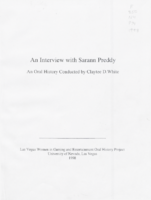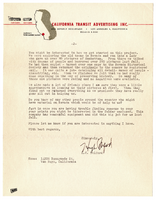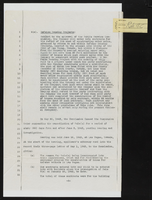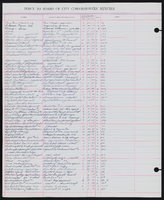Search the Special Collections and Archives Portal
Search Results
Audio clip from interview with George Simmons conducted by Claytee D. White, December 13, 2013
Date
Archival Collection
Description
Audio clip from interview with George Simmons. In this clip, Simmons talks about his work with Sproul Homes in Las Vegas and his career designing homes and structures for Test Site.
Sound

Transcript of interview with Charlene Herst by Barbara Tabach, September 09, 2016
Date
Archival Collection
Description
In 2014, Charlene, n?e Friedkin, Herst retired from her state government career, settled into volunteer work, being a mother and grandmother, and being a grant writer for others. After thirteen years in Carson City, she came back home to Las Vegas. Charlene was eight years old when her parents, Patricia and Richard Friedkin, moved their family to Las Vegas from northern California. She remembers vividly the hot day that they arrived and moved into a rental house in the desert across from Woodlawn Cemetery. Her father, formerly in the grocery business, found work at Vegas Village. Two years later they moved ?into Las Vegas at the very edge?which was Oakey.? She recalls people she has known since those first years who have been instrumental in the growth of Las Vegas; the challenges of being a divorced single mother of four; and the career path that began with an invitation from Gene Greenberg to apply for a part time position at Channel 3, where he was sales manager. At Channel 3 she quickly went from part time to full-time. She started the Community Projects Board, which brought together nonprofit organizations together at the studio in the 1980s to identify and develop marketing campaigns that addressed social issues in the community. Initiatives included Baby Your Baby and Smoking Stinks. While working for Channel 3, she also attended UNLV and received a communications degree in 1995. In 1997 she worked at Sierra Health Services in public relations. Then in October 2001, Charlene started her career in state government as the Nevada State Health Division?s Manager of the Tobacco Program. Over the course of her thirteen year career with the state, she was promoted to positions that continued her dedication to improving the quality of life of all Nevadans. She was instrumental in the implementation of the Nevada Clean Indoor Air Act (2006); improving prevention services to women; reducing the rate of substance use and abuse in the state. The date of her retirement, October 10, 2014, was officially proclaimed in honor of Charlene Herst by Governor Brian Sandoval.
Text

Transcript of interview with Michael S. Mack by Barbara Tabach, May 20, 2015
Date
Archival Collection
Description
In this oral history Michael Mack discusses his early memories of Las Vegas such as attending the Fifth Street School and activities him and his friends participated in. The interview also includes his memories of different members of the Mack family and their activities. He reminisces about his many visits to the Flamingo Hotel as well as being taken by his parent to floor shows. He also discusses what it was like to grow up Jewish in Las Vegas and the way Jews helped build the community.
Text

Transcript of Interview with Eddie & Johnie Wright
Date
Archival Collection
Description
Eddie & Johnie Wright met met, married in 1957, and raised their family in Las Vegas. Johnie arrived in Las Vegas in 1941, teaching first grade at the Westside school, eventually becoming a nurses aide. Eddie came to Las Vegas from Arkansas, and became the first black ticket agent at the local Greyhound station.
Text

Transcript of interview with Sarann Knight Preddy by Claytee D. White, June 5, 1997
Date
Archival Collection
Description
Interview with Sarann Knight Preddy conducted by Claytee D. White on June 5, 1997. Preddy moved to Hawthorne, Nevada, in the 1940s, becoming a business owner and president of the NAACP. Later she moved to Las Vegas, where she served as a community activist and worked as one of the first black 21-dealers.
Text

Transcript of interview with D. D. Cotton by Claytee D. White, February 14, 1997
Date
Archival Collection
Description
Interview with D. D. Cotton conducted by Claytee D. White on February 14, 1997. Raised in New York City, Cotton arrived in Las Vegas as a dancer in Cab Calloway's traveling production "The Cotton Club." During a period of strained race relations, she stood for equal rights as the first black cocktail waitress on the Strip and one of the first black dealers.
Text




